La citadelle écarlate (The Scarlet Citadel)
Adapted from R. E. Howard's short story by Luc Brunschwig, with line art by Étienne Leroux and colours by Hubert Boulard.
Already the fifth volume in Glénat’s
Conan series, this chapter is probably the closest we’ve seen to date to a “regular” Conan story (I mean that it could have been published at Marvel without anyone raising an eyebrow). I initially feared that this might mean the book would be quite ordinary, and was agreeably surprised to be proven wrong. It does carry its own atmosphere and has its own slant on how Conan the king would act.
![]()
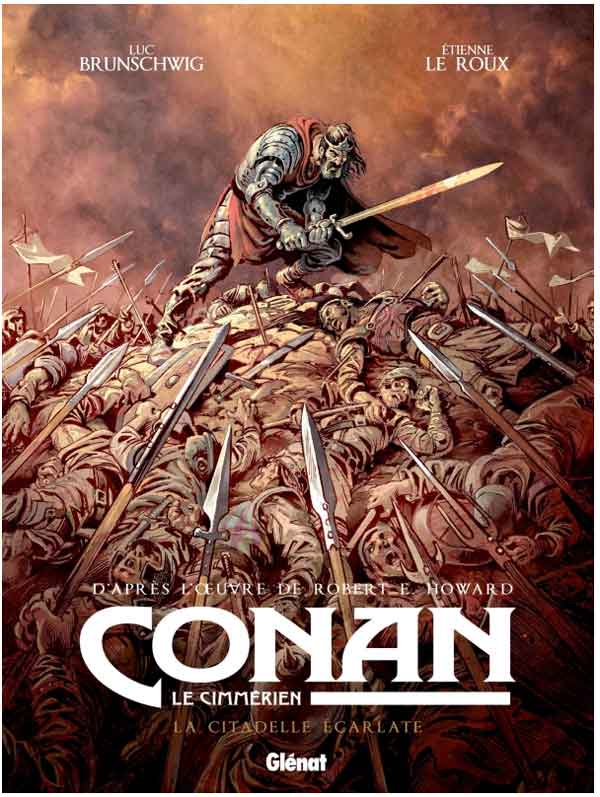
The art reminds me a little of P. Craig Russell at times, as well as of Geoff Isherwood (or Russell inked by Isherwood). Much to my delight, the style adopted by Leroux is not the type of fantasy art in which clothes are impractical, weapons are impossibly big or shaped into baroque forms, and architecture is both radically anachronistic and physically improbable. This looks like a tale set in the French Middle Ages, in agreement with Robert Howard’s depiction of his Conan stories set in Aquilonia.
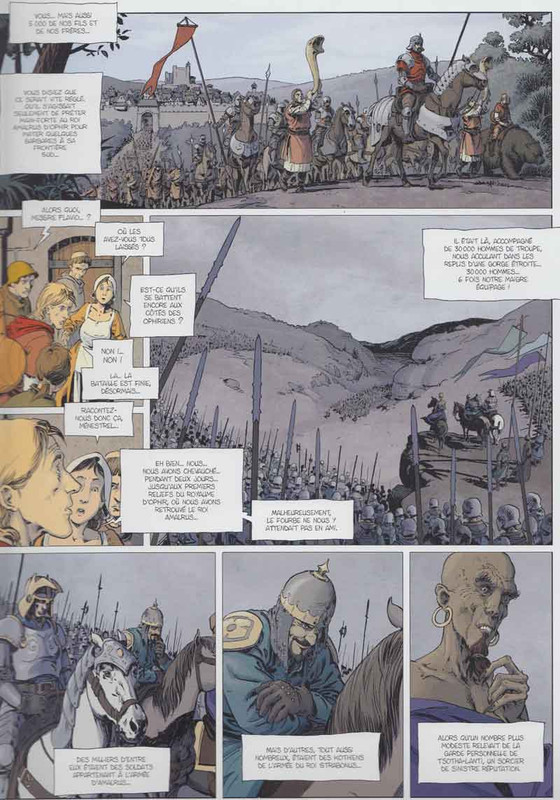
Brunschwig sticks pretty much to the plot of the prose story, and what he changes often adds an extra dimension to the tale. Purists might frown at that (and I tend to frown a lot when things are changed in Howard’s tales), but here the changes really give the story more depth. Details to follow.
The Scarlet Citadel is another story in which plotters want to topple King Conan from the throne of Aquilonia, as happened in
The Phoenix on the Sword, the first published Conan story, and
The Hour of the Dragon, the only Conan novel.
King Conan answers a call for help by the king of Ophir, his southeastern neighbour, to fight against barbarians at the latter’s southern border. (One wonders what barbarians that could be, since to the south of Ophir are the very civilized kingdoms of Argos and Koth. Where's Roy Thomas when you need him???) But it was a trap, as the king of Ophir (Amalrus) has struck a deal with the king of Koth (Strabonus) to take down the Cimmerian usurper and replace him with a puppet ruler. Helped by the magic of the wizard Tsotha-Lanti, the Ophireans and Kothians crush the Aquilonian force and capture Conan.
A bear-riding ministrel who is our point of view character for the first few pages brings the news of what seems to be Conan’s death back home. His riding a bear is not an excursion into fantasyland, rest assured: it’s not an actual mount, it’s only the dancing bear he shows on marketplaces. In fact, not used to being used as a beast of burden, the bear collapses, dead, as they make it to town.
Prince Arpello, secretly the scoundrel chosen to replace Conan, receives the news with feigned surprise and starts making himself into the only choice to replace the heirless Conan. He starts by taking control of the capital, with everyone's best interests at heart, of course.
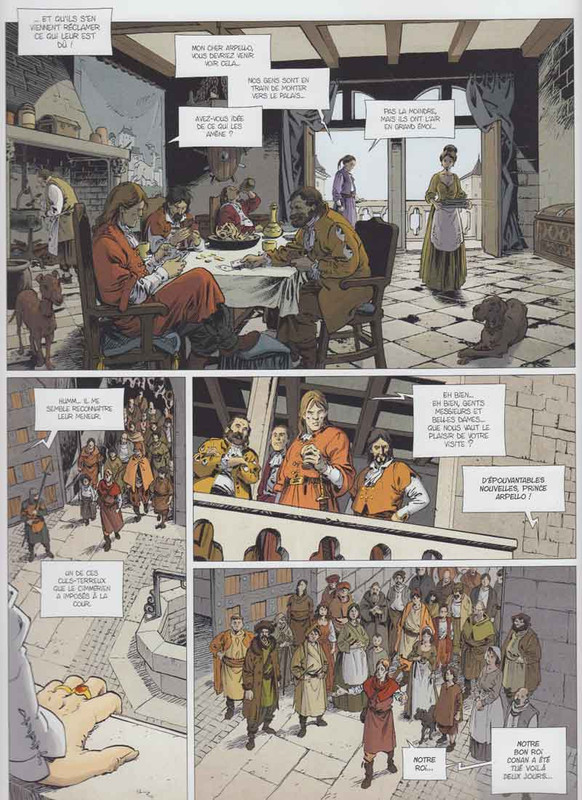
Our hero is not dead, naturally, and he is brought to a great fortress in Koth, the Scarlet Citadel. (While Howard’s citadel was set in Khorshemish, Koth’s capital, this one is isolated in the mountains. It is
said to be in a city, according to what the characters say, but really isn’t. Look at all those naked mountains and cliffs! That ain't no city, no sirree!)
Conan is offered a deal: he will sign his abdication in favour of Arpello, which will help legitimize the usurper and make the military occupation of Aquilonia by “friendly” foreign forces more palatable; in exchange, the Cimmerian will be set free and given as much gold as he can carry. (This act of betrayal would of course help make him less popular in the eyes of his people). Nice tiling work on the citadel's floor, by the way! (I suspect it was done by computer -that's how I would have done it anyway- but it sure looks nice and will be seen a few times more).

Conan naturally refuses, and stresses that he’s very much a “little people” kind of king, while his captors (and Arpello) are blue-blooded leeches. I fart in your general direction and your father smells of elderberries.
Conan is brought to the labyrinthine caverns under the citadel to reflect on the kings' offer; we will learn that when the city was built, the workers found these caverns while digging foundations and that all sorts of horrors were found therein, leading to their being sealed for 3,000 years. Only recently has the wizard Tsotha-Lanti had them reopened. (Tsotha-Lanti's origin is not discussed in this story; it was actually a pretty cool one, in which it is strongly suggested that he is the son of a loathsome demon).
Meanwhile, in Aquilonia, we are given an expansion of Howard’s original text. Nobles loyal to Conan depart the capital city of Tamar, not wanting to serve whoever might replace him. (They are not Prospero nor Trocero, two characters met in Howard’s prose). This of course makes the population uneasy, as there are rumours of approaching Ophirean and Kothian troops. What’s more, Arpello very cleverly fires Conan’s mercenary troops without paying them, prompting them to start pillaging the city… which gives him an opportunity to attack them by surprise with troops prepared just for this occasion, and pass for a hero in the eyes of the Aquilonians.
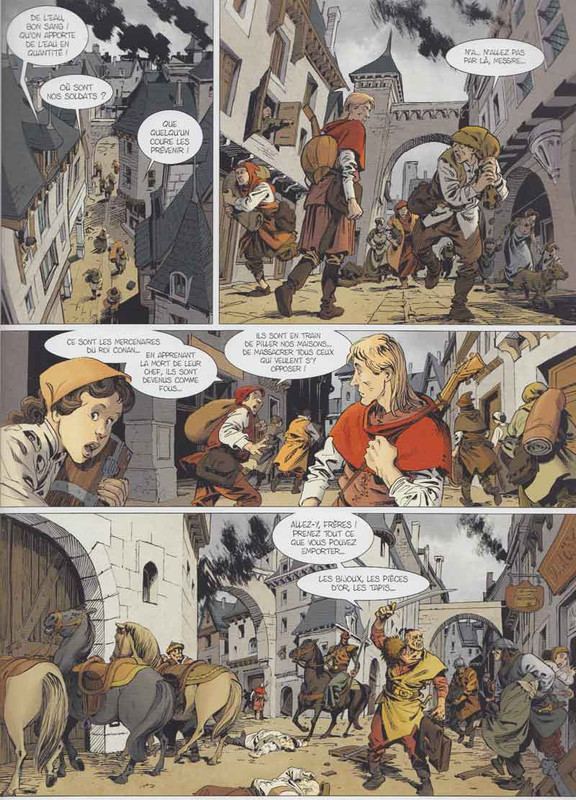
Arpello is promptly made king, disposing of any opponent that might raise their voice (mostly merchants who sided with Conan against the excessive power of the nobility).
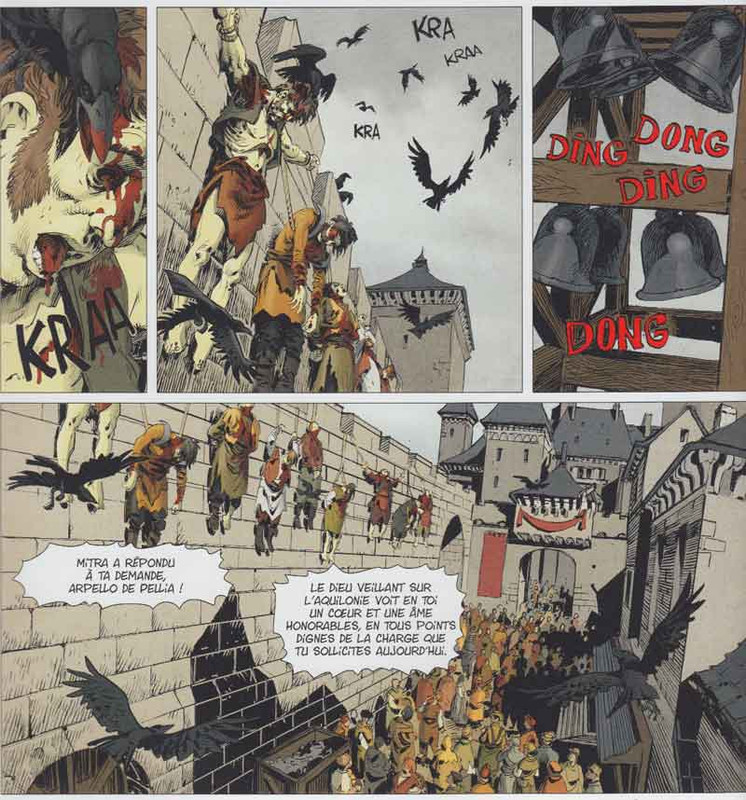
Shortly thereafter, already abusing his power, Arpello murders our ministrel friend because the lad honestly points out that while the people were truly loyal to Conan, they now support Arpello only out of fear of the invaders.
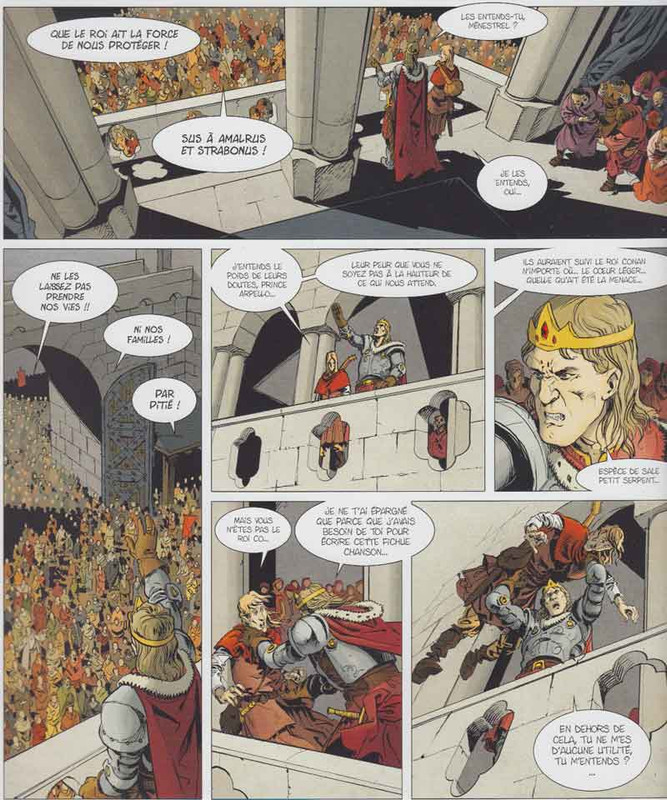
This doesn’t stop Arpello from enjoying the perks of being king, starting with his review of Conan’s harem. (Well, it’s not called a harem here, because we’re no longer in 1932… they’re Conan’s “attendants”).
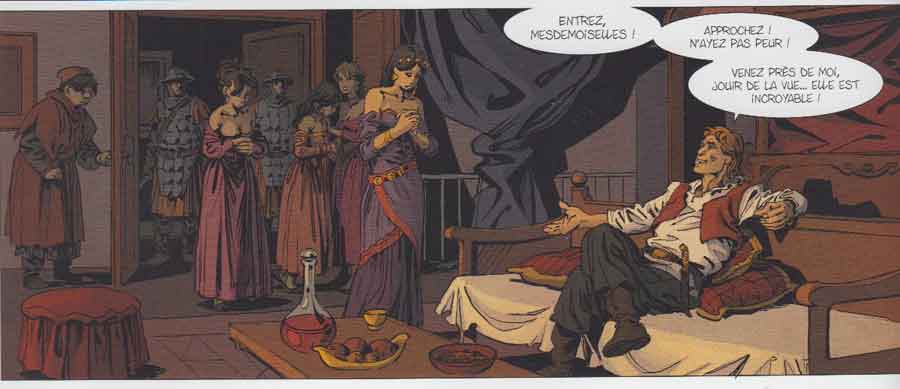
The idea that Arpello would abuse his women was a point made in the Howard story, one that made Conan very angry indeed (and also quite anguished, because he remains a gentleman at heart).
And speaking of the rightful king, still chained in the dungeons… He is being visited by a nasty-looking critter. The giant snake of the original story has been replaced by a giant toad reminiscent of the one Mike Mignola introduced in Dark Horse’s adaptation of
the Halls of the Dead, in which it had replaced a giant lizard. Those toad things are the go-to guys when a giant reptile is unavailable, I guess.
Instead of staying still as in the prose story, Conan jumps around to escape the frog’s prehensile tongue until the beast is scared off by the arrival of a sword-bearing man.
Taunting Conan with the possibility of his freedom (for he has stolen the keys to the Cimmerian’s chains), the fellow’s original motivation went like this:
(He wanted to take revenge on the leader of the Black Corsairs and was just there to rattle his chain before kiling Conan).
In this new adaptation, the guy was just a child when Conan’s raiders attacked his home. His brother killed, the kid had then been taken captive by Stygian slavers and sold to Tsotha-Lanti.

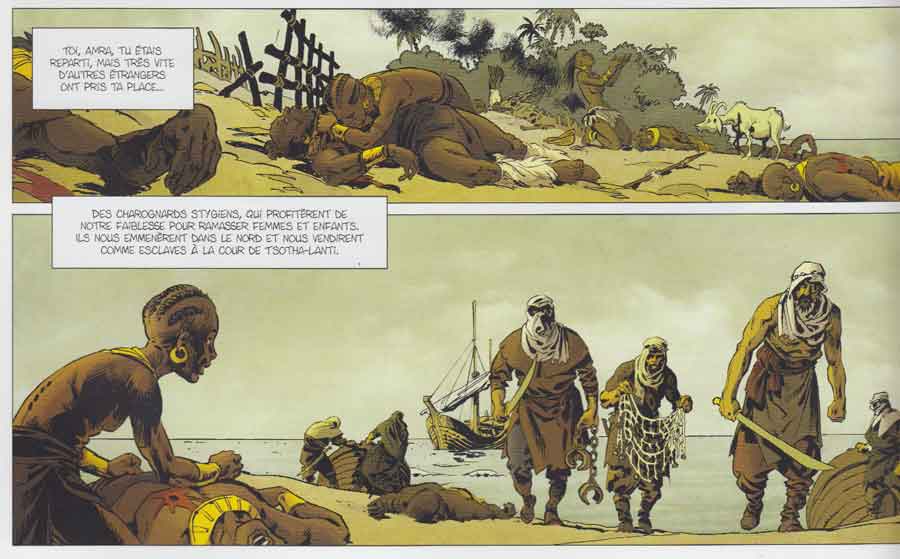
I think it’s cool that no mention is made of Bêlit. She is not mentioned either in any other Conan story apart from
Queen of the Black Coast, even when people discuss Conan leading the Black Corsairs. In fact, even if parsimony would suggest that Conan led them
only when he was with Bêlit, it could very well be that he did so on more than one occasion. Conan’s life as a pirate is actually pretty hard to fit in any sort of sensible chronology, because of contradictions in Howard’s initially unpublished stories. (Not Howard’s fault; it’s quite understandable that drafts and rough ideas would contradict each other until made ready for publication).
Okay, back to our story: this time around, our man is not out for revenge but actually wants to be compensated for his losses. Not as dramatic as in the prose story, but a lot more sensible! He and Conan bargain hard, until the returning toad gets the ambitious negociator and eats him (luckily leaving sword and keys behind).
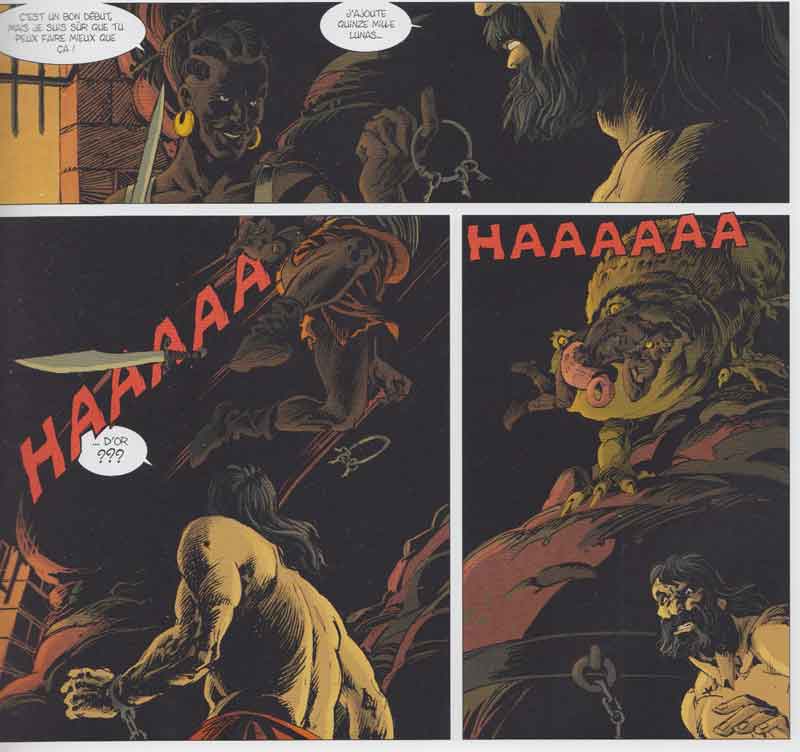
Conan recovers the keys and frees himself, but can’t escape the dungeons on account of a huge portcullis that can only be operated from the other side. The visitor had opened it and left it open after clobbering its guard, but the latter has since come to and has shut the gate again. The guard brags about it to Conan from the other side of the bars, and the Cimmerian promptly stabs him.
With no other option, the Cimmerian searches for another escape down the tunnels, where he meets all sorts of nightmares.

Eventually Conan encounters a man trapped by some hellish plant that seems to feed off him; freed, the fellow reveals that he is Pellias, a wizard who was a competitor of Tsotha-Lanti. It is the latter who caught him, ten years earlier, and condemned him to this grisly fate.
Once he’s awake, Pellias proves to be a formidable wizard and precious ally. Thanks to the sorcerer they get out of the tunnels, and Pellias summons a creature of the air to carry Conan back to his kingdoms. (In the original, this creature simply lived in the upper layers of our atmosphere the same way a dog lives on the ground and a fish in the ocean, and Pellias had called it from up there; in today’s story, the creature was another prisoner in the citadel. Somehow that strikes me as less cool).
As the forces of Ophir and Koth march on Tamar, Aquilonia's capital, Conan flies in and dispatches the traitorous Arpello. Take that, defiler of women!
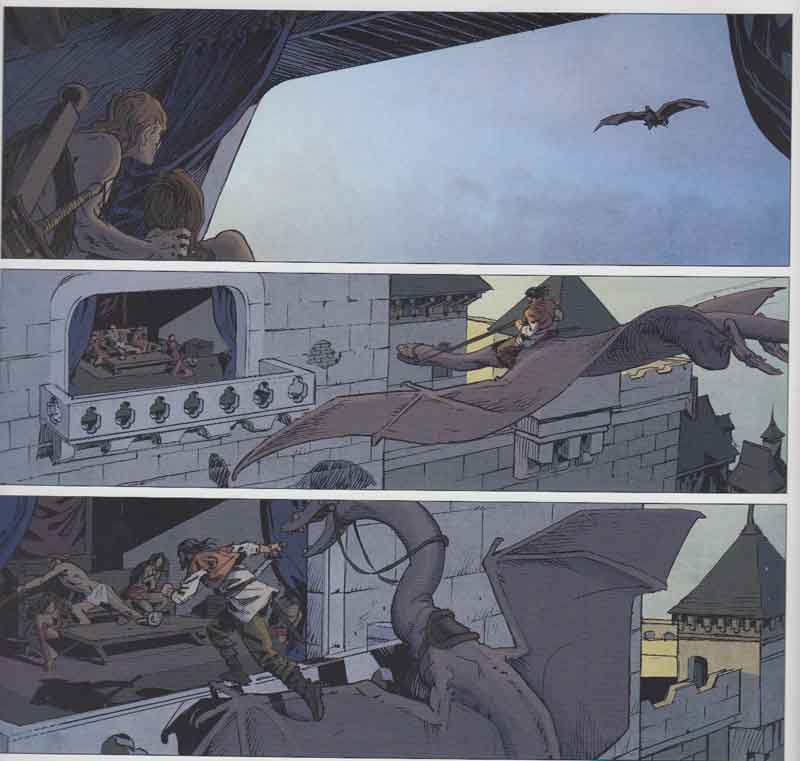
Then we get to an interesting deviation from Howard’s manuscript. There are no more Aquilonian troops present to defend Tamar, and so Conan raises the city’s population. He’s always been on the side of the commoners, and he gives them a rousing pep talk on how they, the people, can see to it that they remain free in their own land.

The civilians charge the Ophirean and Kothian armies, and Conan quickly makes his way to where the wizard and the two enemy kings supervise the battle. We are then treated to either a good dose of realism or of psychological warfare, as Tsotha-Lanti reproaches Conan for his actions. He who claims to defend the common folk has refused a deal that would have guaranteed their safety, and instead he has led them against two professional armies. Even as they talk, the Aquilonian civilians are being butchered. Isn't Conan a hypocrite?
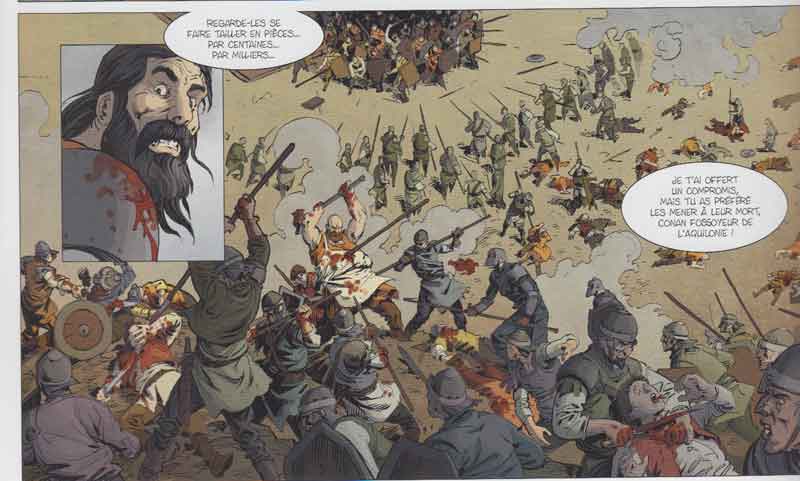
Conan recognizes the veracity of Tsotha-Lanti’s words, but nevertheless decapitates him. Tsotha-Lanti’s head laughs at the Cimmerian, saying that his body will just pick the head off the ground and replace it on its shoulders, when it is instead picked by a flying creature. (It was an eagle in Howard’s story; here it is a sort of winged tiger). The creature is Pellias in another form or, since we saw that very creature earlier in the dungeons, it is merely possessed by Pellias. In any case, the odds of Tsotha-Lanti’s head being reunited with its body anytime soon seem remote at best, even discounting all the terrible things that Pellias will doubtless visit upon it.
Conan then proceeds with his plan of multiple regicide against Amalrus and Strabonus. Just as in
Hamlet, very few people are left alive at the end of the tale!
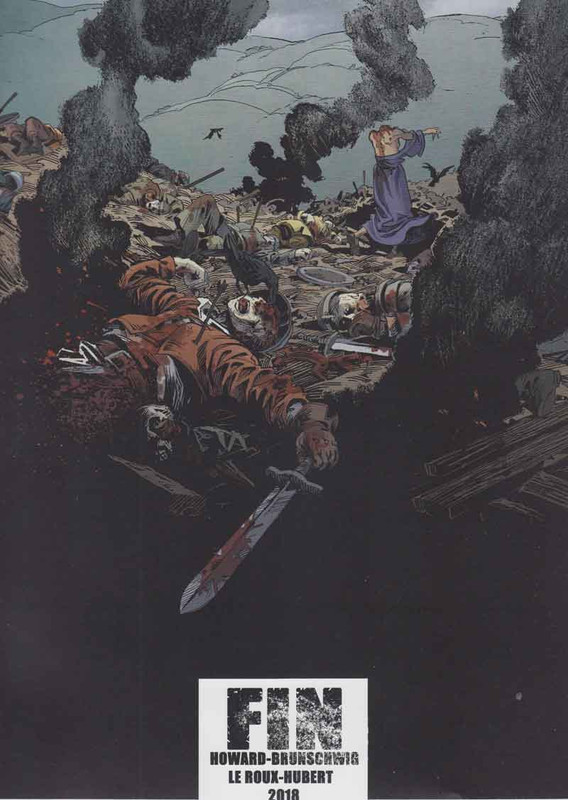
The story is completed by a few scholarly comments by Patrice Louinet (who in my opinion should
really stop harping on L. Sprague de Camp) and by a few pin-ups by various artists (one of them featuring a Conan sporting a bizarre pot belly).
The book as a whole is a good instalment in this series, and better than I expected it to be. It does not replace
Savage sword of Conan #30 as my favourite adaptation of
The Scarlet Citadel, but I like it better than the Dark Horse version.
I liked how no attempt was made to link this story to any other; how Bêlit is not mentioned, for example, and how Aquilonia’s capital is Tamar (not Tarantia), as in Howard’s story. Even Trocero and Prospero, recurring characters of sorts, have been removed from today’s story (even though they were in Howard’s manuscript).
The relation between Conan and his people is also interesting; while not a revolutionary who sends nobles to the guillotine, we see that the Cimmerian has curtailed the powers of the nobility and that they are no longer free to exploit their serfs as they see fit. Accordingly, the people rising to Conan’s banner at the end carries a lot more weight.
One slight additon struck me as pretty cool: when Pellias and Conan try to escape the dungeons, Pellias resurrects the slain guardsman who has access to the lock. In Howard’s story, the wizard just wakes him up for a while; here, he takes a little bit of Conan’s life force (seen as a tiny blue flame escaping from the Cimmerian’s mouth) and puts it is the guard’s own. Conan looks as if he’s not too sure about those shenanigans!
The next chapter will be
Iron Shadows in the Moon, and as I understand it it will be adapted by a lady. I
really look forward to it, especially since the point of view character in that tale is a woman.